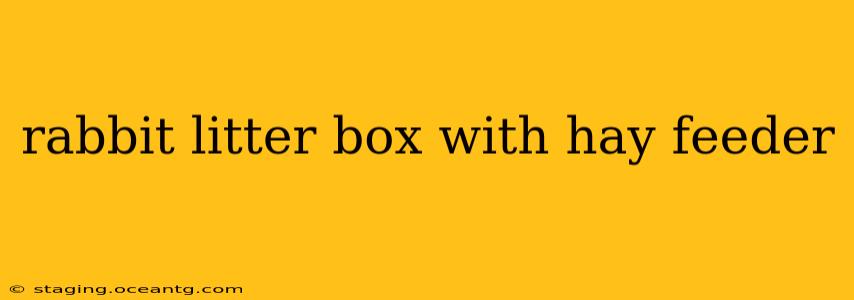Keeping a rabbit happy and healthy involves providing a clean and stimulating environment. A crucial part of this is having the right litter box setup, and incorporating a hay feeder can streamline your routine and improve your bunny's overall well-being. This guide explores the best practices for combining a litter box and hay feeder for your rabbit, addressing common questions and concerns.
Why Combine a Litter Box and Hay Feeder?
Many rabbit owners find that strategically placing a hay feeder near the litter box encourages natural rabbit behavior. Rabbits naturally associate eating with eliminating waste. By placing the hay feeder adjacent to the litter box, you can encourage your bunny to use the litter box consistently, minimizing the chances of unwanted messes outside the designated area. This simple adjustment can significantly improve your cleaning routine and keep your home cleaner.
What are the Best Types of Rabbit Litter Boxes?
Choosing the right litter box is paramount. Rabbits need a spacious litter box to comfortably accommodate their size and movements. Consider these types:
- Large, shallow litter boxes: These provide ample space and prevent your bunny from having to awkwardly stretch to eliminate. Look for boxes at least twice the length of your rabbit.
- Corner litter boxes: These are space-saving options perfect for smaller spaces.
- Covered litter boxes: These can help contain odors better, but ensure there's adequate ventilation to prevent ammonia buildup which can be harmful to your rabbit. Always prioritize your bunny's safety and comfort over odor control.
What Type of Hay Feeder is Best?
Just as important as the litter box is the hay feeder. Opt for a feeder designed to minimize waste and encourage natural foraging behavior. Here are a few excellent options:
- Hay racks: These suspend hay above the floor, preventing soiling and making it easier for your rabbit to access their food.
- Slow-feed hay feeders: These are designed to dispense hay slowly, helping to prevent your rabbit from gulping it down too quickly. This is especially beneficial for preventing digestive problems.
- Floor-based hay feeders: While potentially less efficient at preventing waste, these can still be a good option, especially if you prefer your bunny to eat at floor level.
Where Should I Place the Litter Box and Hay Feeder?
Placement is key to success. The goal is to create a natural flow for your rabbit’s behavior:
- Locate the litter box in a quiet corner: Rabbits prefer privacy when eliminating.
- Place the hay feeder immediately adjacent to the litter box: This encourages the natural association between eating and eliminating.
- Provide multiple litter boxes: For larger rabbits or if your rabbit's territory extends across multiple areas, consider having more than one litter box. This is especially important if your rabbit has a large living space.
How Often Should I Clean the Litter Box?
Regular cleaning is essential to maintain a hygienic environment and prevent health issues for your rabbit. Aim to spot-clean the litter box daily, scooping out solid waste and wet spots. A full litter box change (with fresh bedding) should be conducted at least once a week, or more frequently as needed.
What Kind of Bedding is Best for My Rabbit's Litter Box?
Avoid cedar and pine shavings, as they contain harmful oils. Opt for:
- Paper-based bedding: These are generally safe and readily available.
- Recycled paper pellets: These are dust-free and absorbent.
- Grass-based bedding: This is a natural and often preferred option for rabbits.
Always ensure the bedding is free of dust and harmful chemicals.
My Rabbit Still Pees Outside the Litter Box – What Should I Do?
Several factors can contribute to this. Consider these possibilities:
- Insufficient litter boxes: Add more litter boxes, particularly in areas where your rabbit frequently urinates.
- Inappropriate litter box location: Move the litter boxes to quieter, more private locations.
- Underlying medical issues: Consult a veterinarian if you suspect medical reasons for inappropriate urination. Urinary tract infections can cause frequent urination outside the litter box.
- Litter type: Your rabbit might not like the current litter. Experiment with different options to find a preference.
Can I use a Multi-Tiered Setup?
While not strictly necessary, some owners find success with multi-tiered setups, incorporating shelves or platforms with the litter box and hay feeder on separate levels. This can provide added enrichment and prevent hay from contaminating the litter. Always ensure that the levels are safe and stable.
By thoughtfully combining a litter box and hay feeder, and following these best practices, you can significantly improve your rabbit's hygiene and happiness, creating a cleaner and healthier home for both you and your furry friend. Remember to observe your rabbit's behavior and adjust your setup as needed. A happy rabbit is a healthy rabbit, and a clean environment plays a huge role in achieving both.
